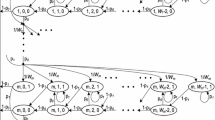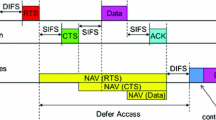Abstract
In the IEEE 802.11 MAC layer protocol, the basic access method is the Distributed Coordination Function based on the CSMA/CA. In this paper, we investigate the analytic performance of IEEE 802.11 DCF in the non-saturation mode. We assume that there is a fixed number n of competing stations and the packet arrival process to each station is a Poisson process. We model IEEE 802.11 DCF in non-saturation mode by a 3-dimensional Markov chain and derive the steady state probability of the Markov chain by applying the matrix analytic method. We obtain the probability generating function of Head-of-Line delay (HoL-delay), non-saturation throughput and packet loss probability. Our results can be used for finding the optimal number of stations that can be accommodated while satisfying a given QoS requirement.
Similar content being viewed by others
References
Bianchi, G. (2000). Performance analysis of the IEEE 802.11 distributed coordination function. IEEE Journal on Selected Areas in Communications, 18(3), 535–547.
Bianchi, G., & Tinnirello, I. (2005). Remarks on IEEE 802.11 DCF performance analysis. IEEE Communication Letters, 9(8), 765–767.
Cheng, S. T., & Woo, M. (2005). Performance evaluation of Ad-Hoc WLAN by M/G/1 queueing model. In ITCC 2005 (Vol. 2, pp. 681–686). International Conference, 4–6 April 2005.
Hamed, M. K., Alaremi, A., Choi, J., Vijaykumar, R., & Roy, S. (2007). Stochastic modelling and analysis of 802.11 DCF with heterogeneous non-saturated nodes. Computer Communications, 30(18), 3652–3661.
Duffy, K., Malone, D., & Leith, D. (2005). Modeling the 802.11 distributed coordination function in non-saturated conditions. IEEE Communication Letters, 9(8), 715.
Foh, C. H., & Zukerman, M. (2002). Performance analysis of the IEEE 802.11 MAC protocol. In Proceedings of the European wireless 2002 conference (pp. 184–190). Florence, Italy, Feb. 2002.
Foh, C. H., & Tantra, J. W. (2005). Comments on IEEE 802.11 saturation throughput analysis with freezing of backoff counters. IEEE Communications Letters, 9(2), 130–132.
Kim, T. O., Kim, J. K., & Choi, B. D. (2008). Performance analysis of IEEE 802.11 DCF and IEEE 802.11e EDCA in non-saturation condition. IEICE Transactions on Communications, E91B(4).
Li, B., & Battiti, R. (2004). Analysis of the IEEE 802.11 DCF with service differentiation support in non-saturation conditions. In Lecture notes in computer science (Vol. 3266, pp. 64–73). Berlin: Springer.
Litjens, R., Roijers, F., van den Berg, J., Boucherie, R., & Fleuren, M. (2003). Performance analysis of wireless LANs: an integrated packet/flow level approach. In Proc. of 18th international teletraffic congress.
Neuts, M. F. (1989). Structured stochastic matrices of M/G/1 type and their applications. New York: Marcel Dekker.
Tickoo, O., & Sikdar, B. (2004a). A queueing model for finite load IEEE 802.11 random access MAC. In Communications (Vol. 1, pp. 175–179). IEEE International Conference, 20–24 June 2004.
Tickoo, O., & Sikdar, B. (2004b). Queueing analysis and delay mitigation in IEEE 802.11 random access MAC based wireless networks. In Proceedings of IEEE INFOCOM, Hong Kong, China, March 2004.
Winands, E., Denteneer, T., Resing, J., & Rietman, R. (2004). A finite-source feedback queueing network as a model for the IEEE 802.11 distributed coordination function. In Proceedings of the 5th European wireless conference: mobile and wireless systems beyond 3G.
Wireless LAN MAC and PHY Layer Specifications (1999). LAN MAN standards committee of the IEEE computer society Std. ANSI/IEEE 802.11.
Author information
Authors and Affiliations
Corresponding author
Additional information
This research is supported by the MIC (Ministry of Information and Communication), Korea, under the ITRC (Information Technology Research Center) support program supervised by the IITA (Institute of Information Technology Assessment).
Rights and permissions
About this article
Cite this article
Bae, Y.H., Kim, K.J., Moon, MN. et al. Analysis of IEEE 802.11 non-saturated DCF by matrix analytic methods. Ann Oper Res 162, 3–18 (2008). https://doi.org/10.1007/s10479-008-0315-4
Received:
Accepted:
Published:
Issue Date:
DOI: https://doi.org/10.1007/s10479-008-0315-4




